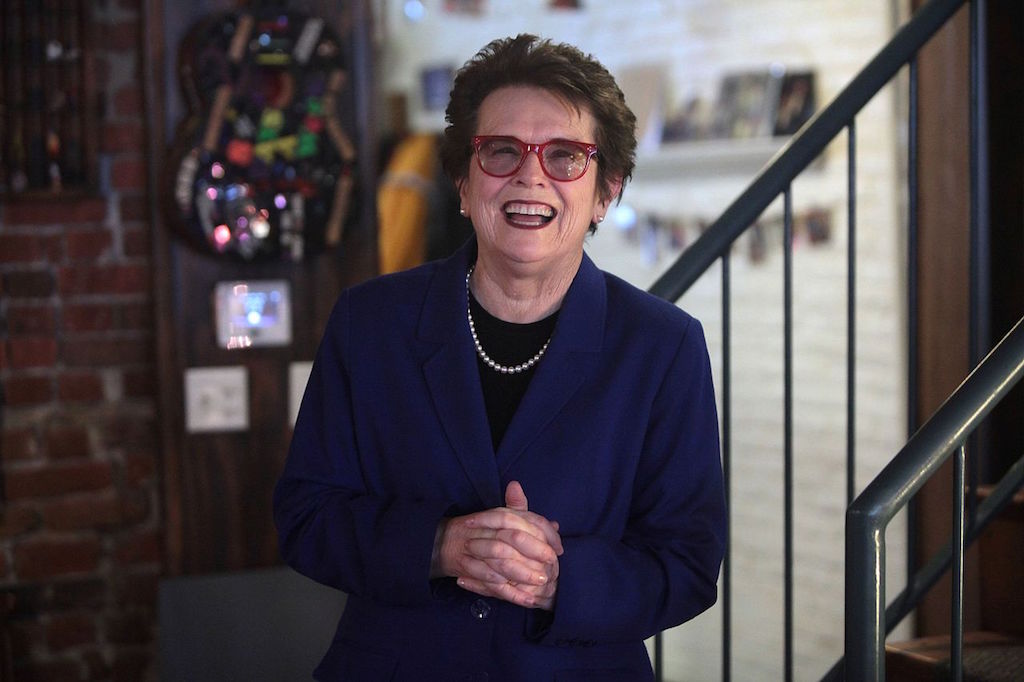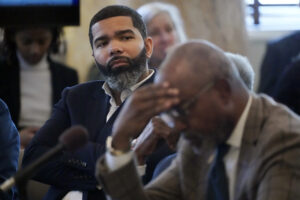Billie Jean King, the Women’s Champion
The tennis Hall of Famer became “the single most important person in the history of women’s sports” after beating Bobby Riggs in 1973. Billie Jean King. (Gage Skidmore / Wikimedia)
Billie Jean King. (Gage Skidmore / Wikimedia)
On Sept. 23, 1973, a record 50 million Americans did something unprecedented: They tuned in for a prime-time tennis match, not for the love of the game itself but for the sexual politics that had generated a circus-like media frenzy leading it up to it. The match between retired former world champion Bobby Riggs and the biggest name in women’s tennis, Billie Jean King, was famously dubbed “The Battle of the Sexes.” It was a defining moment for women’s athletics, and ultimately, women’s rights.
Riggs was the betting favorite, though he was 55. King, 29, was on a streak unheard of for a female athlete. In 1969, she had won all four grand slam titles (Australian Open, French Open, Wimbledon and U.S. Open), and in 1972 had become the first female athlete to earn over $100,000 in a year.
Sports Illustrated named her (along with UCLA basketball coach John Wooden) Sports Person of the Year, the first woman accorded that honor. It’s easy to forget that the road to the Battle of the Sexes was a long one, filled with unusual moments, a share of the national imagination and an element of ugliness over the real battle, one that is still being fought, for women’s equality.
Bobby Riggs had been a star of the sport since 1939, when he won Wimbledon and the U.S. National Championship (now the U.S. Open) at the age of 21. He retired in 1959 and was inducted into the Tennis Hall of Fame eight years later. He then found great success on the senior circuit.
Billie Jean King had been a star softball player whose parents encouraged her to switch to tennis because they deemed it more “lady like.” She practiced on public tennis courts in her hometown in Long Beach, Calif. It was always her stated goal to take tennis from the stuffy exclusivity of country clubs and make it a popular sport. She succeeded in ways she couldn’t have imagined when she turned pro in 1959—the year Riggs retired—at age 16.
She struggled against the constraints and prejudices of the tennis establishment, in particular the disparity in pay between male and female winners—the ratio favored men by as much as 8-to-1. The frustrations came to a head in 1970 when she and eight other women, later called the “Original Nine,” started their own circuit in protest of the United States Lawn Tennis Association. It was a tour of eight tournaments, sponsored by Virginia Slims. By the end of year, their numbers swelled to 40, including Margaret Court, King’s rival for the top seed. In 1973, they formed the Women’s Tennis Association. King, of course, was the first president.
Riggs approached King with the idea of a match, dangling a $35,000 prize. She vehemently declined, seeing the idea as demeaning to women and to tennis. Not long after, Margaret Court unseated King for the rank of No. 1 in the world. Riggs then made the offer to her. Their match took place on Mother’s Day 1973. Riggs presented Court with a bouquet of roses as she curtseyed. What followed was called at the time the “Mother’s Day Massacre” after Court managed to score only three points. The conclusions that most commentators quickly came to were that even the best woman in the sport could not compete with their male counterparts, and that women could not handle the pressure of such an event. (Court retired in 1977, ironically, before she could benefit from the changes that Billie Jean King helped usher in.)
As soon as the Mother’s Day match ended, Riggs challenged King again, this time for a $100,000 prize. He then named himself the No. 1 female player of the world by reason that he had beaten the former No. 1. King accepted the challenge, but she understood that she was in a position of power and stipulated that she have approval of key aspects. She later confessed that she “thought it would set us back 50 years if I didn’t win that match. It would ruin the women’s tour and affect all women’s self-esteem.”
For the most part, King’s suggestions were easily agreed to. The only real conflict was over Riggs’ choice for TV commentator, Jack Kramer. Kramer, a star player in the 1940s and early 1950s, was a personal friend of Riggs, but that was not the reason King turned him down. He helped found the Association of Tennis Professionals and was its first executive. He consistently undermined the women players and had come into direct conflict with King on the issue of pay, leading her to organize the women’s circuit.
King threatened to drop out of the match if Kramer was allowed to call the match. She was quoted as saying, “He doesn’t believe in women’s tennis. Why should he be a part of this match?” The network tapped the legendary and highly abrasive announcer Howard Cosell to handle play-by-play with No. 3-ranked Rosie Casals, who was suggested by King and was one of the original nine, serving as the color analyst.
Even his critics would not deny Riggs his talent for being an effective, if outrageous, promoter. He staged multiple photo ops for the press, practicing with a frying pan instead of a racket during one. In perhaps the most offensive of these sessions, he dressed as Little Bo Peep and played while herding live sheep around the court. He hosted large poolside parties. At one, he line-danced with cheerleaders whose shirts spelled out his name.
At these parties he was very vocal about his opinions on women and women in sports, describing himself as a “male chauvinist pig” and calling King “the leading women’s libber of tennis.” Their match, Riggs proclaimed, “would send women back to the kitchen where they belonged.” It almost makes one cringe that he made the cover of Time magazine. Most cringe-worthy of all was a nude photo shoot for another publication with a strategically placed racket.
When Sept. 20 finally came, the Houston Astrodome was sold out, with over 30,000 people in attendance. King entered the court on a feathered litter, while Riggs arrived in a rickshaw pulled by scantily clad models. He was sponsored by the candy Sugar Daddy and wore a bright yellow jacket emblazoned with the name. He then gave King an enormous Sugar Daddy. Not missing a beat, King presented her opponent with a piglet, eliciting a genuine laugh from Riggs.
Riggs scored the first point, causing some dismay among King’s fans. But King had watched and learned from the Court-Riggs match. Shifting from her usual aggressive style, she stayed at the baseline, easily handling Riggs’ soft shots.
At the beginning of the third set, Riggs finally took off his Sugar Daddy jacket and dropped his comedic act. He was forced to change form from his own usual style, but it did him no good. The final score was 6-4, 6-3 and 6-3 for King. A straight three-set victory in tennis is usually not exciting, but the ratings for the ABC broadcast showed that millions of tennis fans (an estimated 50 million in the United States and 90 million worldwide) were glued to their sets to the very end and for the post-match ceremonies.
Some critics tried to disparage King’s victory on the basis that she was 26 years younger than Riggs, conveniently forgetting they had overwhelmingly picked Riggs to win. Jack Kramer, for instance, said he didn’t think King “played all that well. She hit a lot of short balls which Bobby could have taken advantage of had he been in shape.” What Kramer chose to overlook was that Riggs had never stopped playing tennis on the senior circuit, where he had a near-perfect win record, and he had beaten Margaret Court, 25 years his junior, just a few months earlier.
To this day, conspiracy theories abound, most famously that Riggs (a gambling addict) owed money to the mob, bet on King to win, and threw the match, a claim that King denied and Riggs’ friends and family still deny. Riggs vehemently denied a fix until his death in 1995. (Several people insist that he took and passed a lie detector test in their presence.)
Riggs, though, was a graceful loser. After the match, he said of King, “She was too good, too fast. She returned all of my passing shots and made great plays off them. … I was trying to play my game, but I couldn’t.” Later that year, the two guest-starred on an episode of “The Odd Couple,” and eventually became friends—though Bobby never gave up hope of a rematch. King attended his funeral in 1995.
Title IX, the federal law that prohibits discrimination based on gender, went into effect in June 1972, but King’s stand for herself, for female athletes and for women gave it life. By the end of the decade, the number of women participating in organized sports exploded at high school, college and Olympic levels. By the early 1980s, nearly every major tennis tournament had equal purses for the champions.
In 2006, the USTA renamed the National Tennis Center in New York City, home of the U.S. Open, for King. During the ceremony, John McEnroe called her “the single most important person in the history of women’s sports.”
Margaret Barra has been writing since the age of 10, when she interviewed the New Yorker’s Pauline Kael for a school project. She has written for Salon and TheAtlantic.com, where her piece on Wes Anderson’s “Moonlight Kingdom” earned a mention on Vulture. She also contributed a chapter to the 2013 book, “Lasting Yankee Stadium Memories: Unforgettable Tales From the House That Ruth Built.”
Your support matters…Independent journalism is under threat and overshadowed by heavily funded mainstream media.
You can help level the playing field. Become a member.
Your tax-deductible contribution keeps us digging beneath the headlines to give you thought-provoking, investigative reporting and analysis that unearths what's really happening- without compromise.
Give today to support our courageous, independent journalists.









You need to be a supporter to comment.
There are currently no responses to this article.
Be the first to respond.